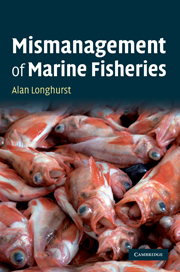Book contents
- Frontmatter
- Contents
- Preface
- 1 From certainty to doubt in fishery science
- 2 The ecological consequences of the exceptional fecundity of teleosts
- 3 Indeterminate growth, negative senescence and longevity
- 4 Marine ecosystems: their structure and simulation
- 5 The natural variability of fish populations and fisheries
- 6 Has sustainability in fishing ever been achieved?
- 7 What is the real state of global fish populations?
- 8 The mechanics of population collapse
- 9 Why don't some fish populations recover after depletion?
- 10 Is the response of the fishery science community appropriate?
- 11 Conclusion: sustainability can be achieved rarely and only under special conditions
- Index
3 - Indeterminate growth, negative senescence and longevity
Published online by Cambridge University Press: 05 July 2014
- Frontmatter
- Contents
- Preface
- 1 From certainty to doubt in fishery science
- 2 The ecological consequences of the exceptional fecundity of teleosts
- 3 Indeterminate growth, negative senescence and longevity
- 4 Marine ecosystems: their structure and simulation
- 5 The natural variability of fish populations and fisheries
- 6 Has sustainability in fishing ever been achieved?
- 7 What is the real state of global fish populations?
- 8 The mechanics of population collapse
- 9 Why don't some fish populations recover after depletion?
- 10 Is the response of the fishery science community appropriate?
- 11 Conclusion: sustainability can be achieved rarely and only under special conditions
- Index
Summary
‘Youth comes with age . . .’
Vaupel et al., 2004The second characteristic of marine fish that requires some preliminary discussion is their great longevity and indeterminate growth, especially when compared to that of terrestrial mammals; the continued growth of fish, almost throughout life, proves to have major consequences for their reproductive pattern that are critical to understand when contemplating the ability of teleosts to serve as a resource base for industrial fisheries. This aspect of their biology (like many others) was almost entirely neglected by classical fish stock management techniques. Consequently, although it has been known for more than 50 years that the eggs of older female teleosts are liable to be larger, to contain more yolk and to produce more viable larvae than those of younger fish, these observations were ignored until very recently, perhaps because they were made on freshwater fish and were published in Russian. This is unfortunate, because they could have led to an earlier understanding that reliance on the surplus production axiom may contribute significantly to stock failure; this problem is the focus of this chapter.
Studies of the reproductive ecology of long-lived Pacific rockfish recently introduced a new concept into contemporary fishery science – that of the BOFF (or big old fecund female); these, it is now suggested, should be protected from fishing mortality because of their critical importance to the reproductive success of the population. Still, I have the impression there is not yet a proper appreciation of the fact that the existence of individuals with these characteristics in pristine populations of teleosts is the general result of the progressive partition of energy between growth and reproduction in all organisms having indeterminate growth trajectories. This observation suggests that a discussion of the comparative ecology of organisms that have indeterminate and determinate growth, respectively, may be in order.
- Type
- Chapter
- Information
- Mismanagement of Marine Fisheries , pp. 34 - 55Publisher: Cambridge University PressPrint publication year: 2010

